Mombasa is a city situated on the coast of Kenya. More precisely, it holds the position of being the second-largest city in the country. What makes Mombasa unique is that, apart from being a city, it also happens to be an island.
Throughout its turbulent history, which has seen it ruled by various powers including the Portuguese, Arabs, and the British, Mombasa has managed to preserve its distinct character. When you visit this city, you will have the opportunity to explore intriguing attractions found on its streets, and you may feel like an uninvited guest at times. However, it’s important to note that all the places in Mombasa are significant not solely for their beauty, but more importantly for the insights they provide into the city and the wider region.
In this article, we will highlight some compelling reasons to visit Mombasa. So, feel free to take a tour and discover the wonders it has to offer.
Początek formularza
Table of Contents
- 1 Is Mombasa Safe For Visitors?
- 2 Fort Jesus (UNESCO)
- 3 Old Town in Mombasa
- 4 New Town in Mombasa
- 5 Old Port of Mombasa
- 6 Baobab Park
- 7 Temples in Mombasa
- 8 Pembe Za Ndovu: Mombasa’s Iconic Elephant Tusks Symbol
- 9 Uhuru Garden
- 10 Exploring a Local Market
- 11 Akamba Tribe Artisan Workshop
- 12 Beaches in Mombasa
- 13 Other Attractions in the Mombasa Area
- 14 Accommodation in Mombasa
- 15 Dining Options in Mombasa
- 16 Mombasa – Why It’s Worth Visiting
Is Mombasa Safe For Visitors?
I’ve received numerous inquiries about the safety of visiting Mombasa independently. Some travelers choose to do so, while others opt for guided tours with a local guide who hails from Mombasa (as we did). This choice can be quite convenient because, in Mombasa, it’s common for Kenyans to approach tourists and offer to show them around, making it challenging to decline such offers.
In terms of safety, it’s worth noting that Mombasa is generally considered safer than Nairobi, Kenya’s capital. However, like in many places, pickpocketing incidents can occur, so it’s wise to stay vigilant. Additionally, you may come across beggars in Mombasa, including children and the disabled.
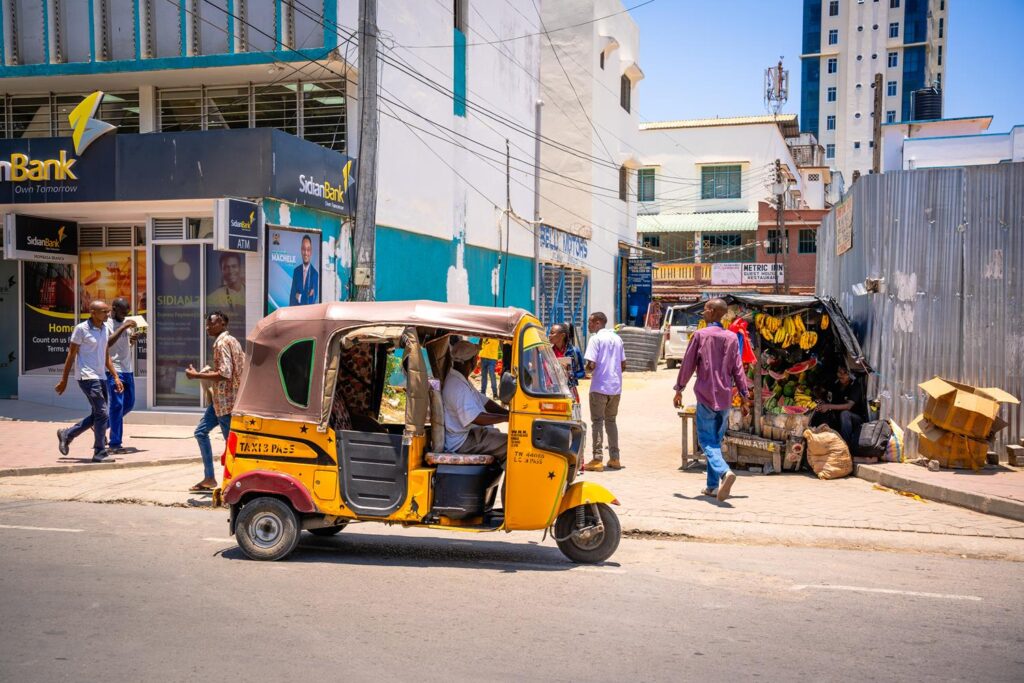
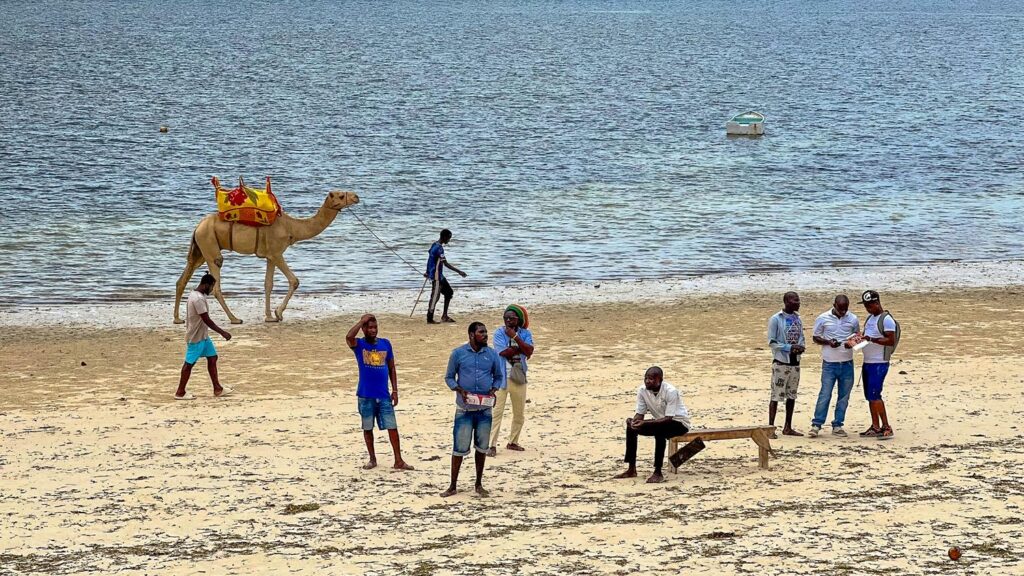
Fort Jesus (UNESCO)
The two most significant attractions on Mombasa Island are Fort Jesus and the Old Town.
Fort Jesus, also known as Boma la Yesu, holds a prominent place in Mombasa’s history. This fortress was constructed in 1593 under the orders of King Philip II by the Portuguese. In 2011, it earned the distinction of being designated a UNESCO World Heritage Site. The 17th century brought significant changes to the fort’s history. During the 1590s of that century, Mombasa was occupied by the Omanis, leading to numerous transformations in the region.
Throughout the 19th century, the Arabs and the British engaged in fierce competition for control of Mombasa, with the fort becoming a pivotal battleground in the struggle for dominance. Eventually, in 1875, the British leased the fort along the coast and used it as a city prison until 1958.
Today, Fort Jesus not only stands as a historic landmark but also houses a small museum. Remarkably, you’ll find a Polish connection on the fort’s walls, including a plaque that commemorates the presence of Polish refugees, numbering around 20,000, in this part of Africa during and after World War II.
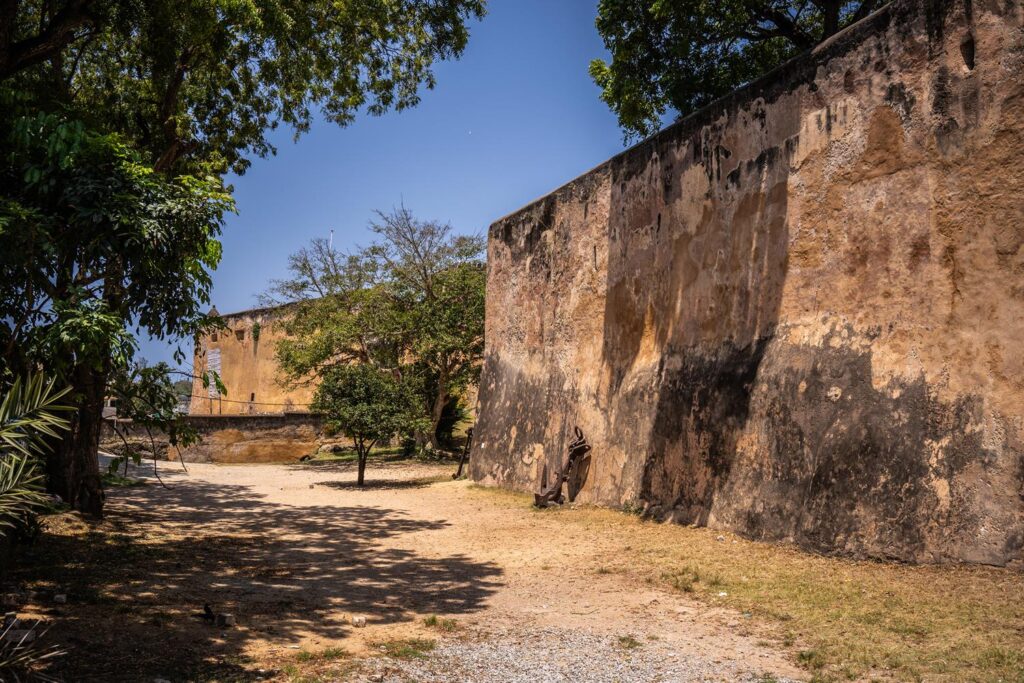
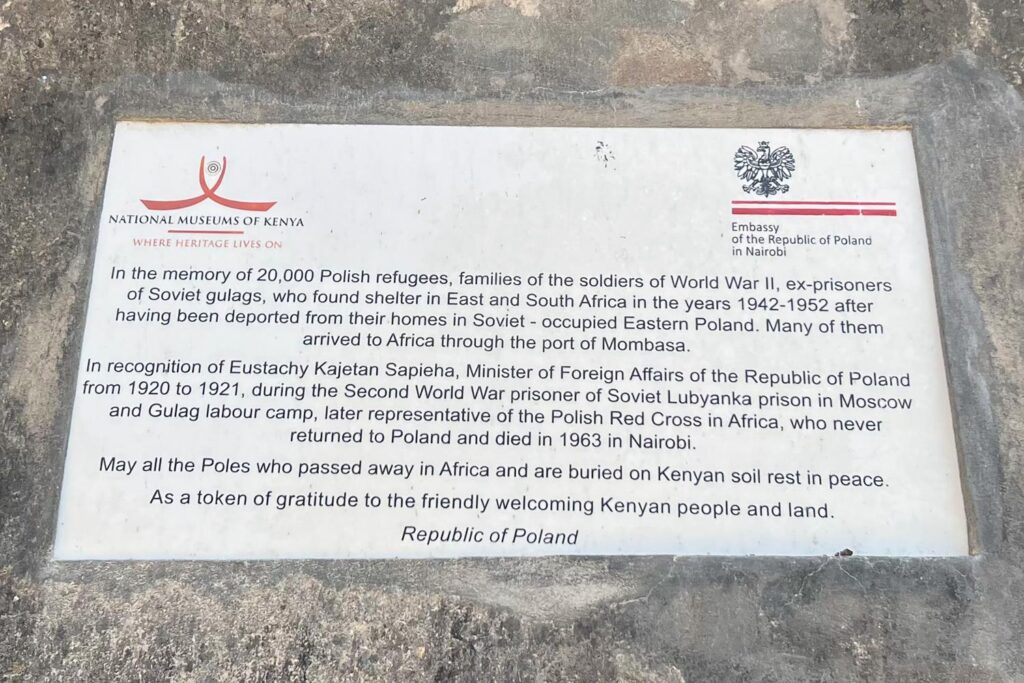
Old Town in Mombasa
While strolling through the Old Town, you’ll have the opportunity to delve into Kenya’s centuries-old history. Here, you’ll encounter buildings dating back to the colonial era, although it’s unfortunate that the Old Town’s historical documentation is somewhat limited.
This particular district of Mombasa is predominantly Muslim, and as such, it boasts several ancient mosques, with many residents adhering to traditional Muslim attire.
Notable landmarks within this area include the Africa Hotel, one of the first hotels to grace Mombasa. It’s intriguing to imagine that from its balconies, there once stretched a breathtaking view of the sea. Another historical gem is the Old Post Office, established in 1899 to facilitate money transfers for the Indian laborers who were instrumental in constructing the railway.
As you explore the Old City, keep an eye out for intricately carved doors, many of which are over a century old. These carvings distinctly bear the influences of Arab and Indian cultures. Additionally, take note of the ornate wooden balconies that adorn the buildings.
An essential piece of information to remember when visiting Mombasa is that Kenya only gained its independence from Britain on December 12, 1963.
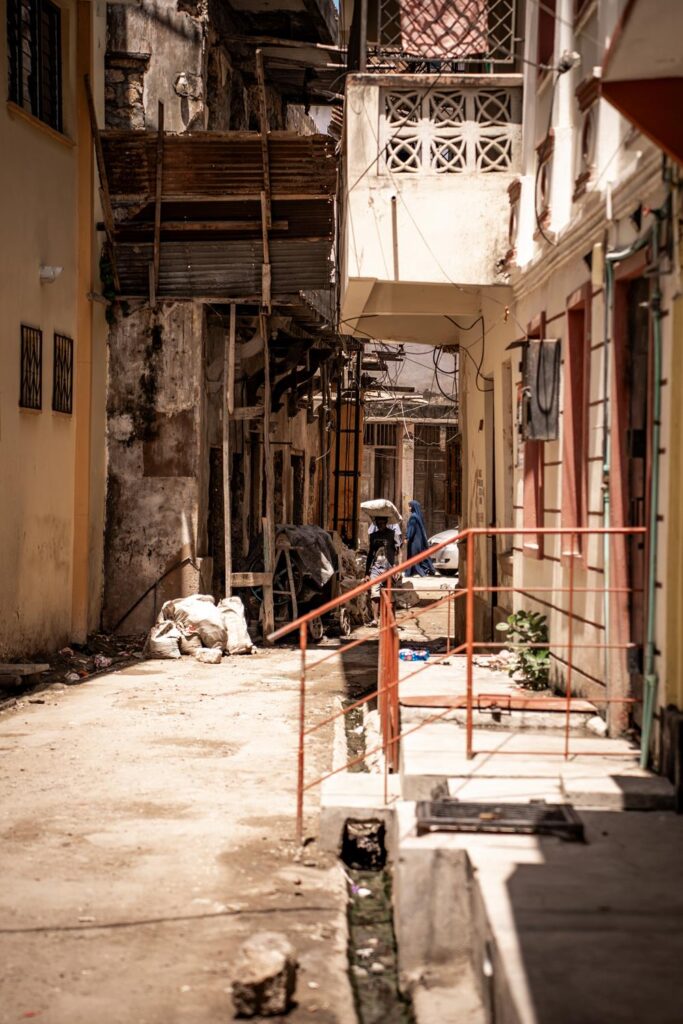
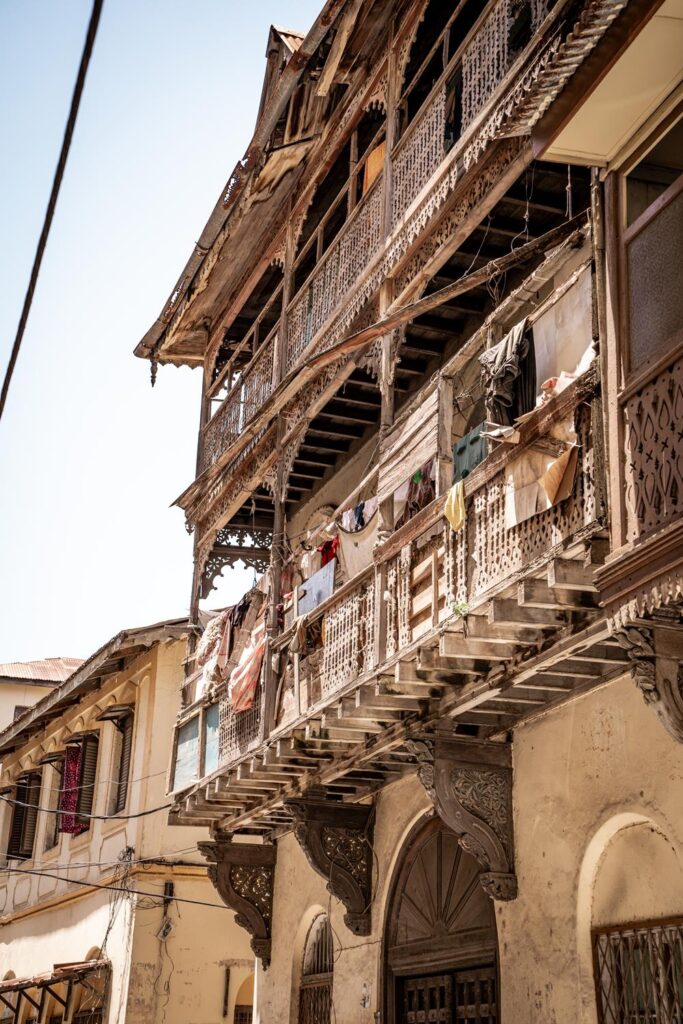
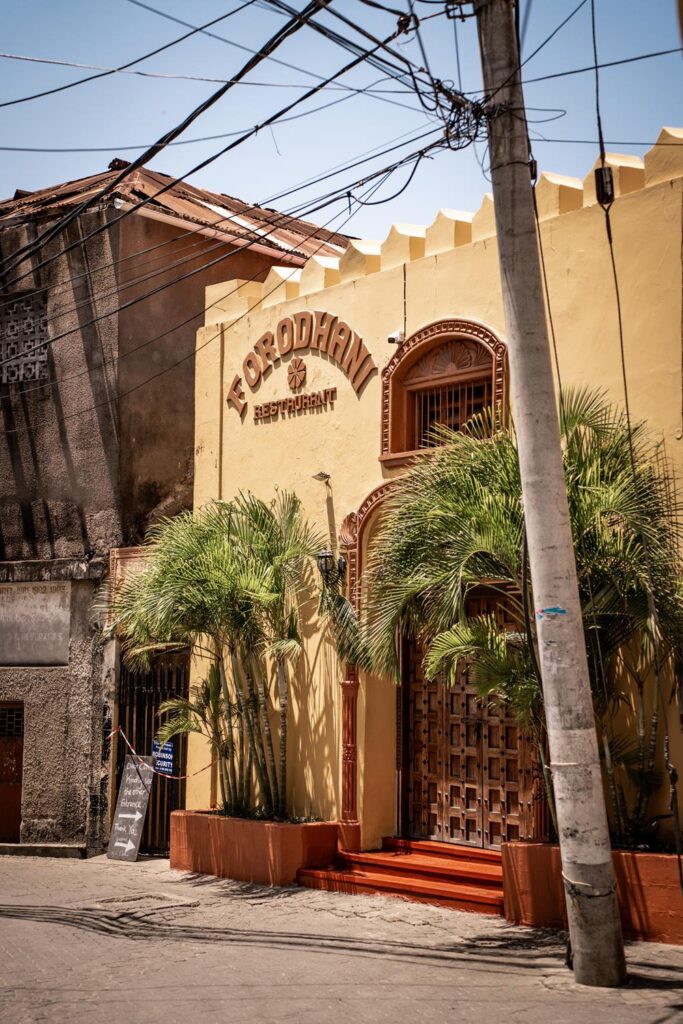
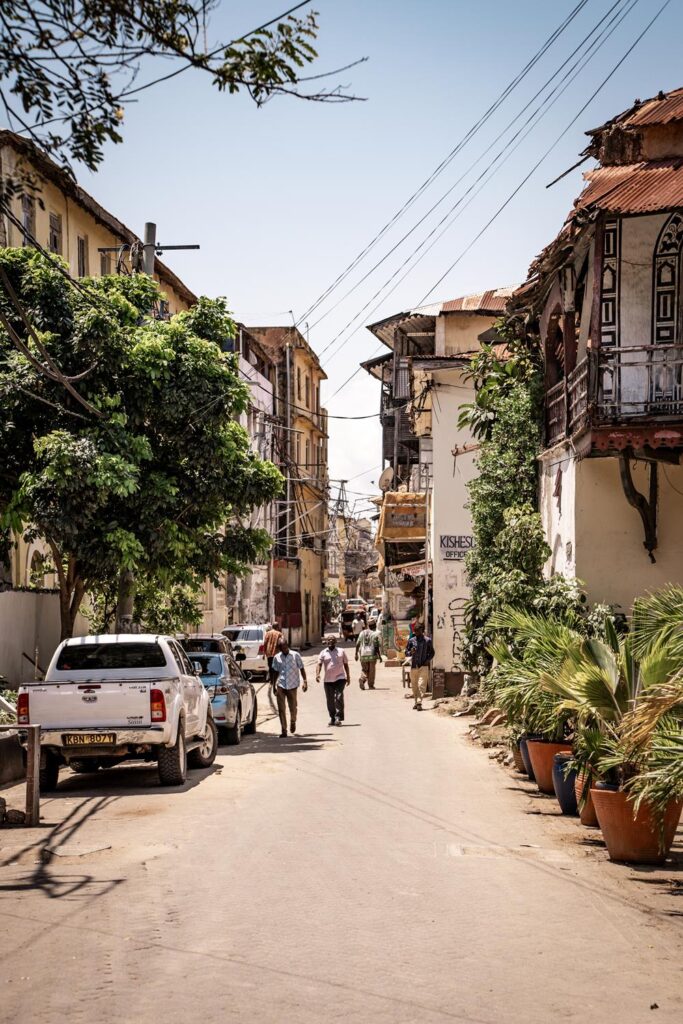
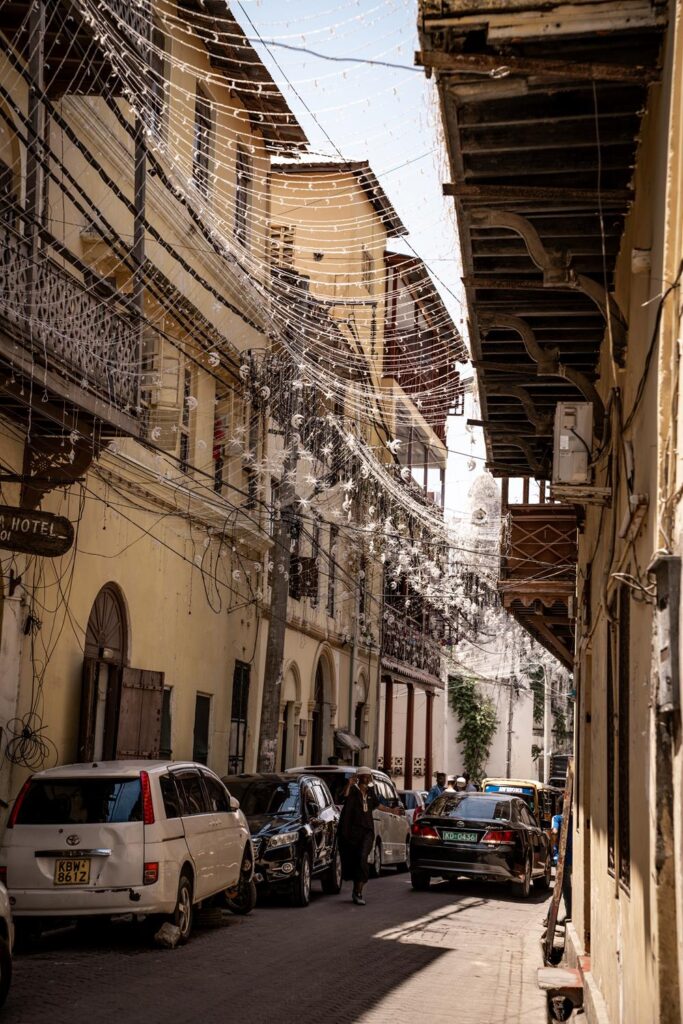
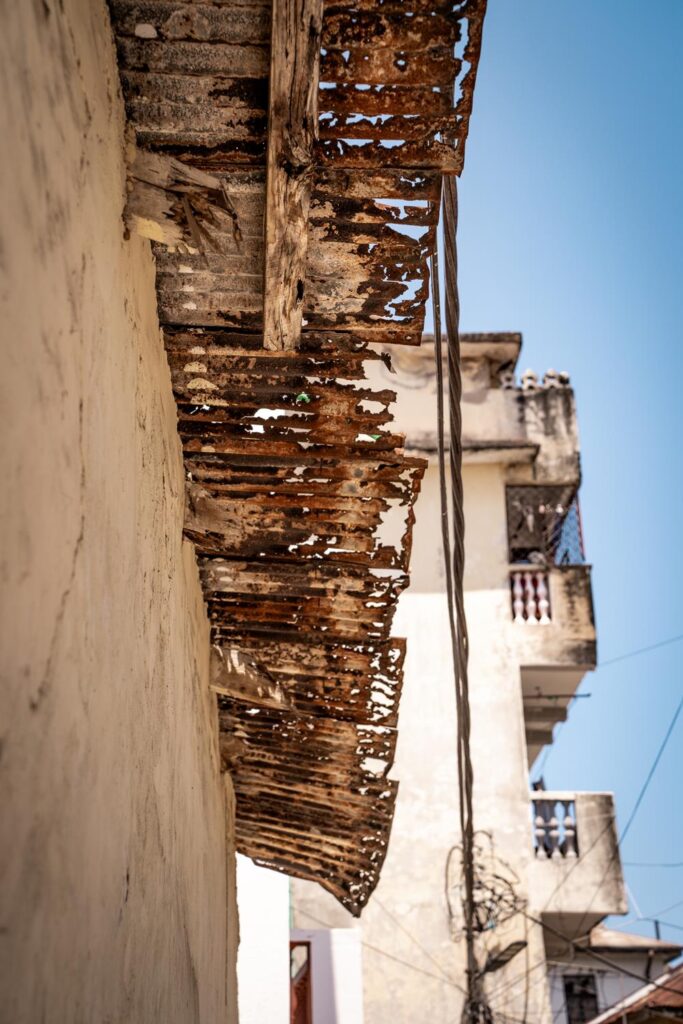
New Town in Mombasa
The distinction between the Old City and the New City often comes down to more than just color. The older buildings, painted in a charming shade of yellow, stand in contrast to the newer structures, which are adorned with a vibrant blue hue. Naturally, these areas also vary significantly in terms of their historical backgrounds and construction dates. However, it’s worth noting that there’s considerably less information available about the New Town.
In essence, while the color contrast may be immediately noticeable, delving deeper reveals a stark contrast in the history, character, and stories of these two facets of Mombasa.
Old Port of Mombasa
The history of Mombasa as a city can be traced back to medieval times when it served as a crucial trading port on the Indian Ocean and the Persian Gulf. Furthermore, Mombasa stands as one of the primary hubs of the Swahili civilization, which thrived along this coastline from the 13th to the 15th centuries.
Situated near the harbor is Government Square.
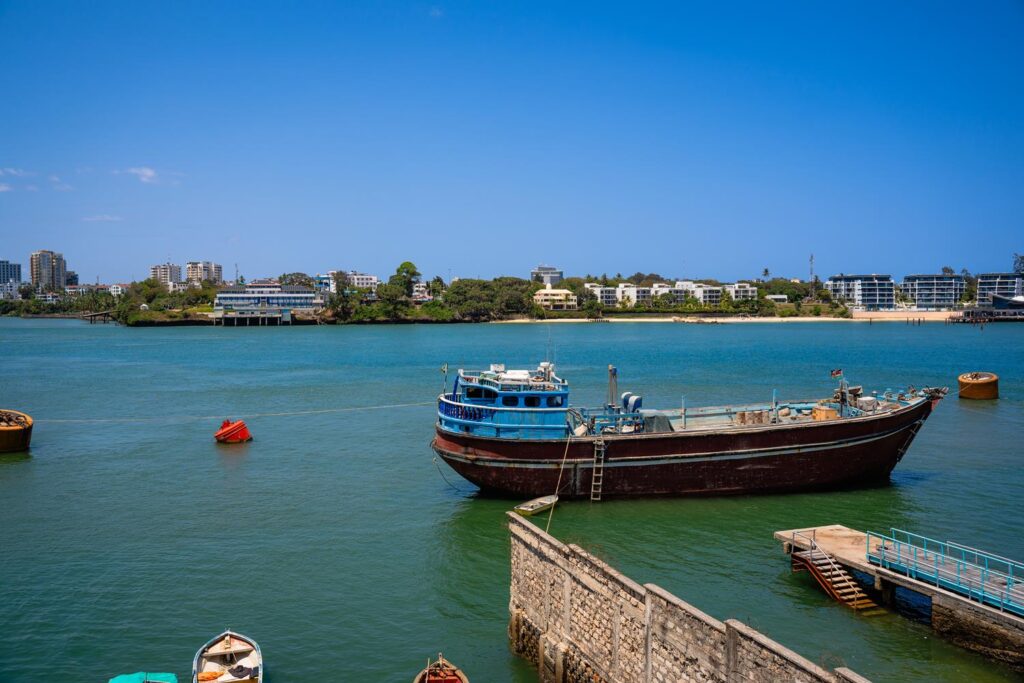
Baobab Park
At Likoni Port, which is located on the island of Mombasa, there is a park adorned with centuries-old baobab trees. It’s certainly worth taking a trip there, as during the day, you’ll encounter locals and quite a few children who visit the park for a respite.
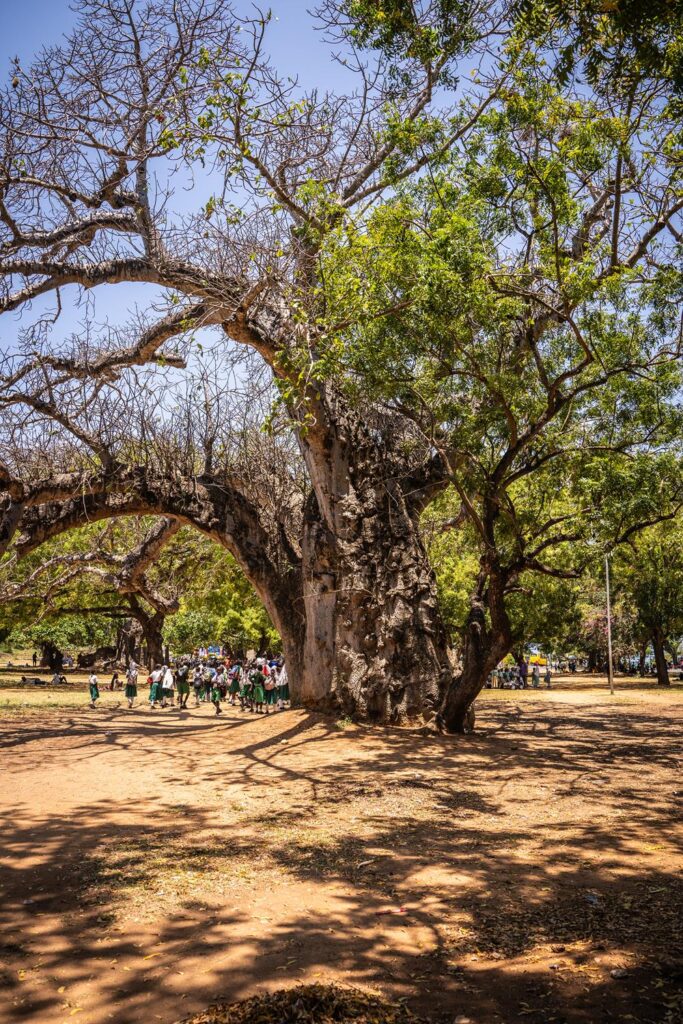
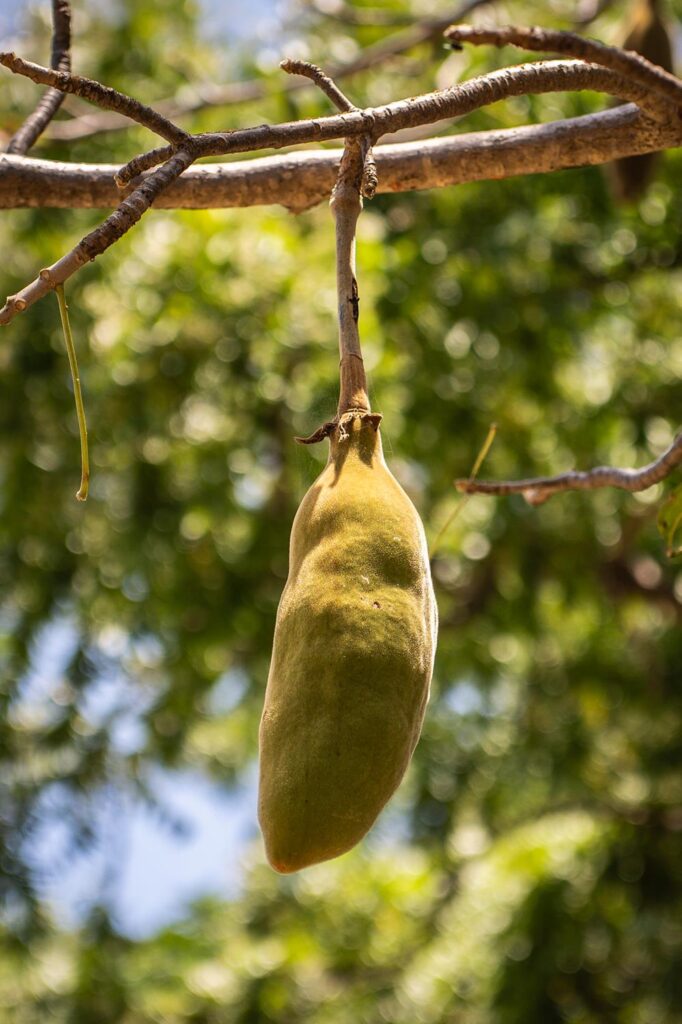
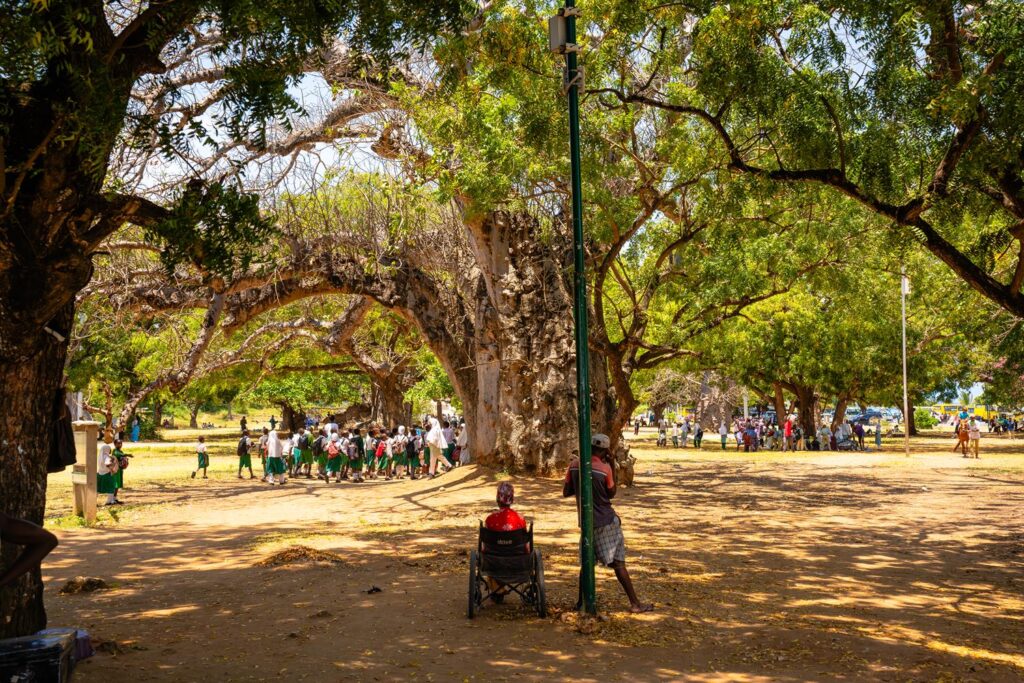
Temples in Mombasa
Kenya is predominantly a Catholic country. However, Mombasa stands out as primarily a Muslim community. In this city, you’ll come across numerous mosques, with the Mandhry Mosque being one of the oldest. It was established in 1570, and the present building likely dates back to 1830. Across the street, you’ll find the mosque’s well, featuring a facade dating to 1901.
Interestingly, Mombasa is also home to Hindu temples, including the exquisite Shri Cutch Satsang Swaminarayan Temple.
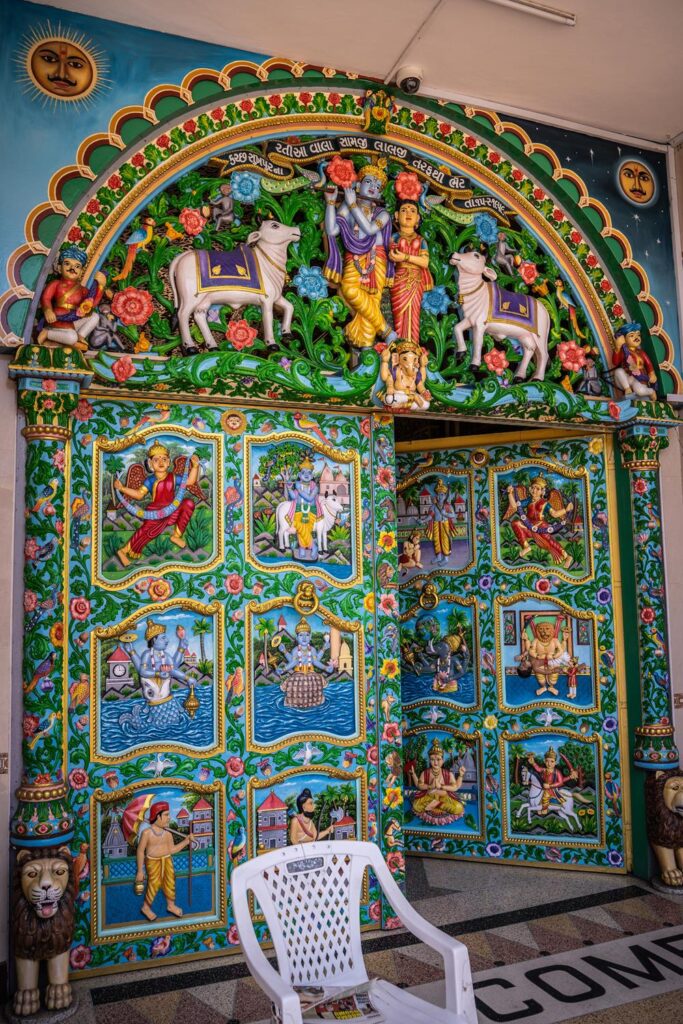
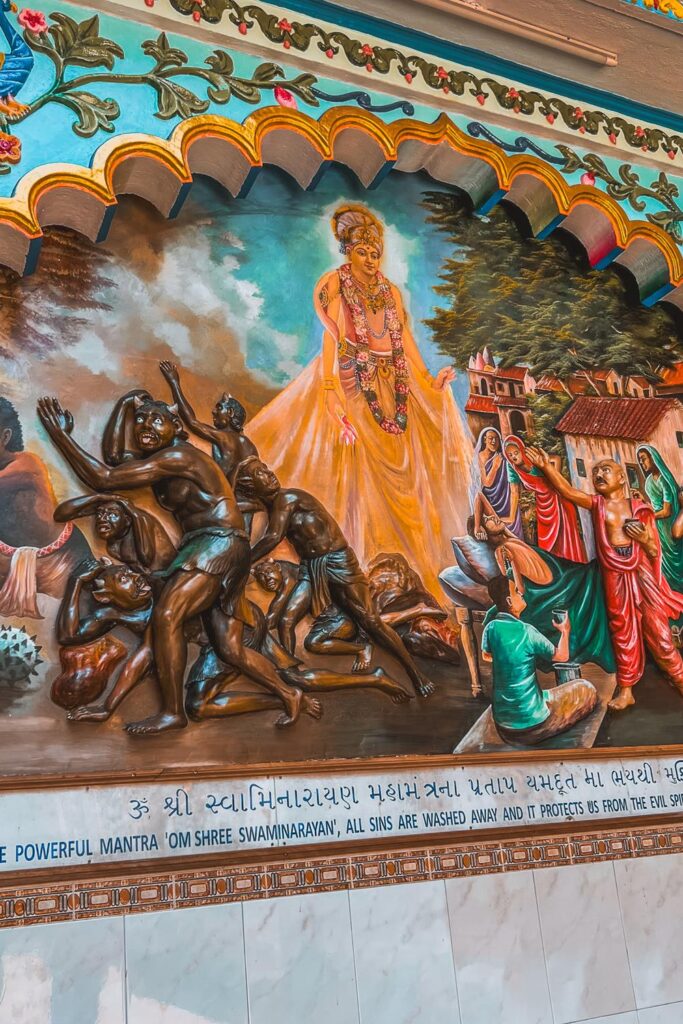
Pembe Za Ndovu: Mombasa’s Iconic Elephant Tusks Symbol
Mombasa boasts a distinctive symbol known as “Pembe Za Ndovu,” which translates to Elephant Tusks in Swahili. This symbol represents the Mombasa Tusk Monument, situated along the city’s main road. It serves as a commemoration of Queen Elizabeth II’s visit in 1952. Originally, the monument featured two wooden structures designed to resemble elephant tusks. However, it underwent an upgrade, transforming into four aluminum tusks arranged in the shape of an M. Over time, this monument has become a notable local attraction and stands as an emblematic symbol of the city.
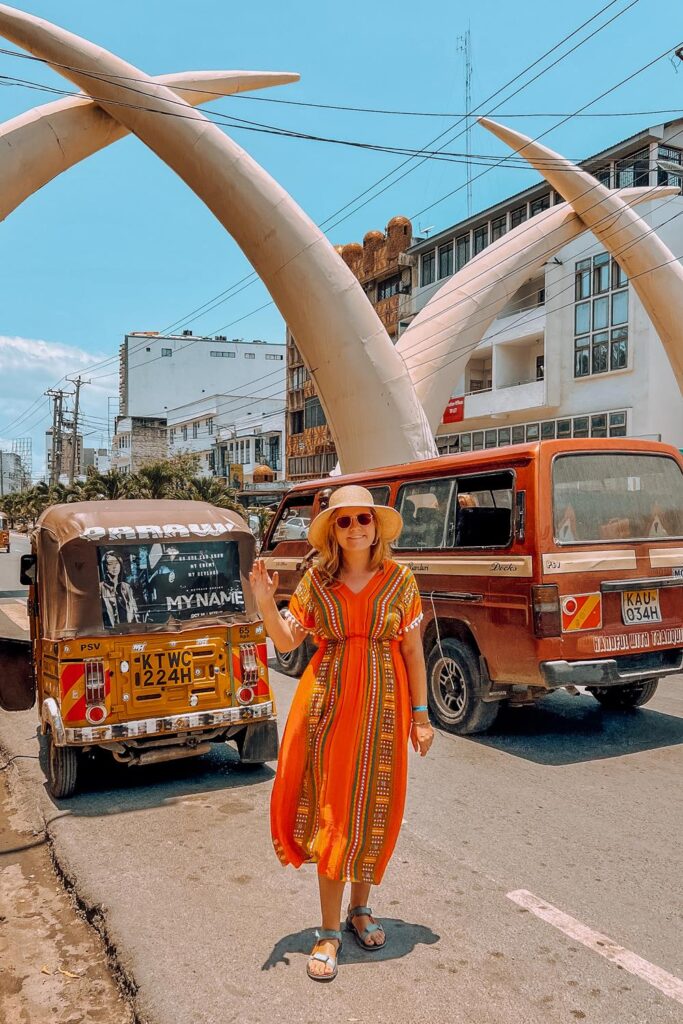
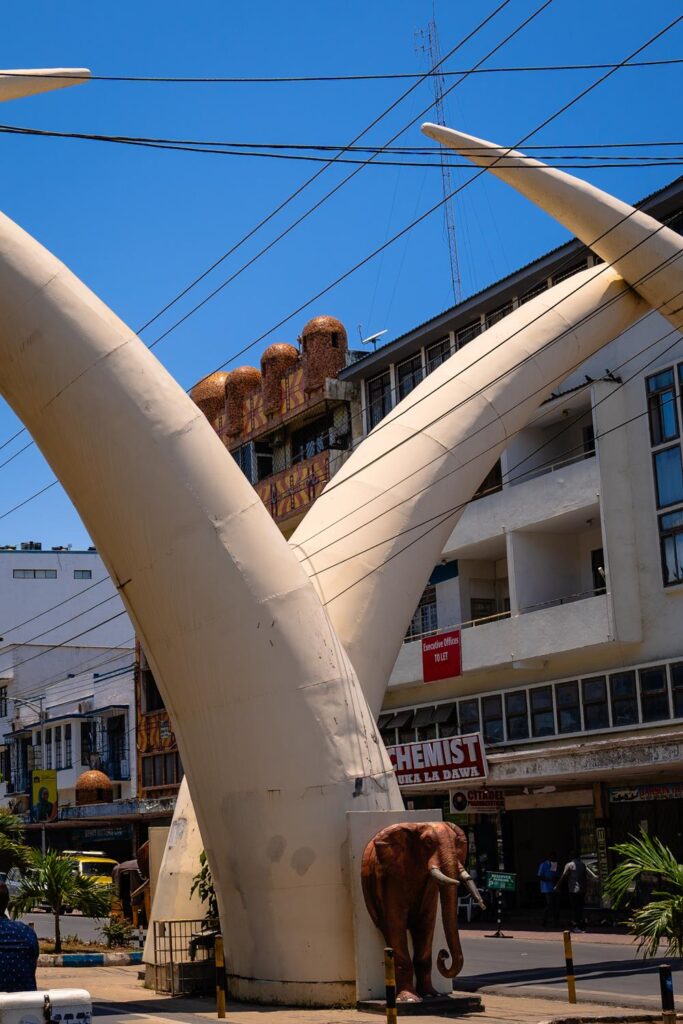
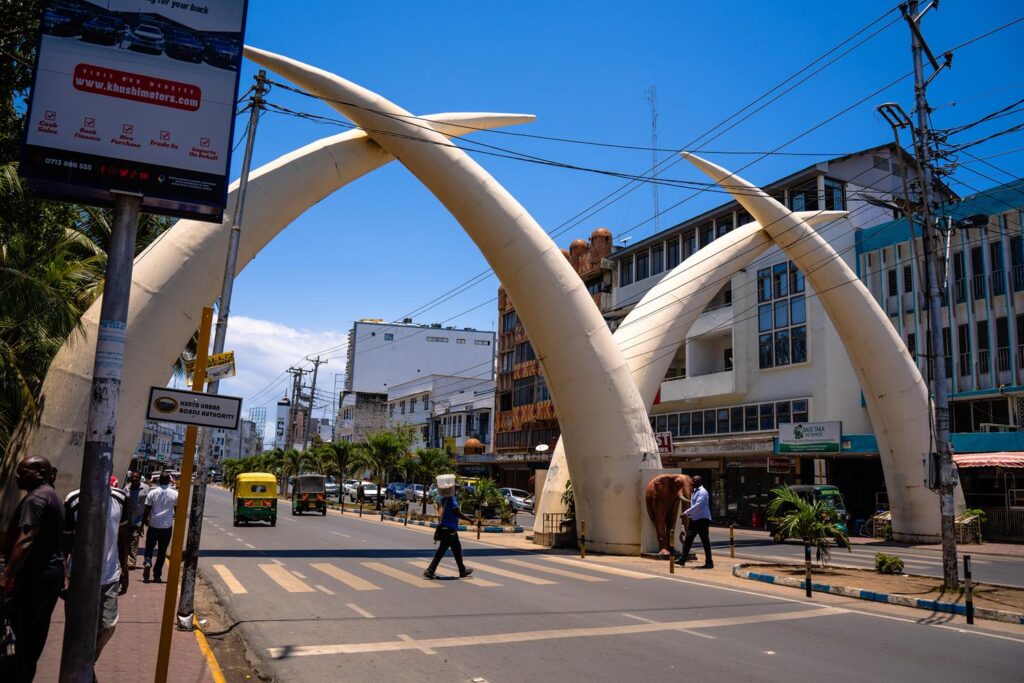
Uhuru Garden
Located right next to the Elephant Tusks is Uhuru Garden. This garden is renowned for its population of bats that inhabit the trees. One particular species, known as the fawn phantom, boasts several thousand individuals within this garden. Bats fulfill crucial roles in ecosystems; however, for some individuals, they also evoke concerns due to their nocturnal behavior and their association with eerie tales. Some people even believe that a jinni, a spirit from Arab mythology with extraordinary powers, resides in the land alongside these bats.
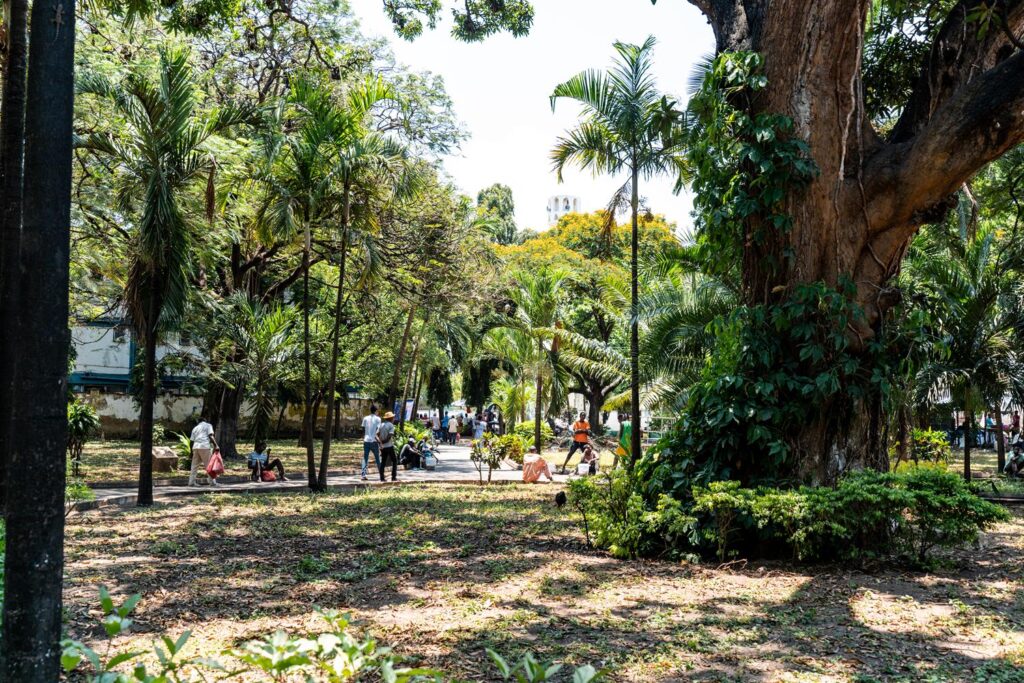
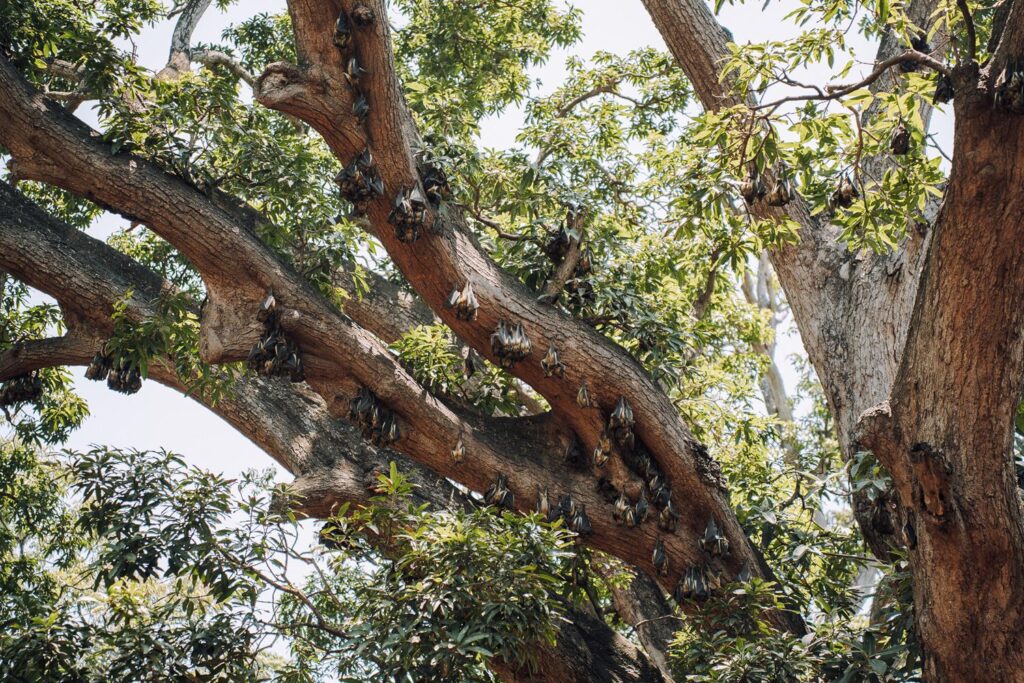
Exploring a Local Market
A visit to Mombasa would be incomplete without exploring the local bazaar, a place filled with enticing aromas and vibrant colors. Here, you’ll find an array of spices, aromatic coffee, and tantalizing tea. In my opinion, it’s definitely worth a visit, but haggling is a must. As a tourist, especially one who is not a local, initial prices may be on the higher side. Whether you succeed in negotiating a better deal depends not only on the seller but also on your bargaining skills.
If bargaining isn’t your preference, you can always opt for the typical stores and markets where all products are priced consistently for everyone. Many people recommend visiting Carefour for this purpose, but I recommend visiting Naivas, which is located nearby and probably has a wider range and better prices.
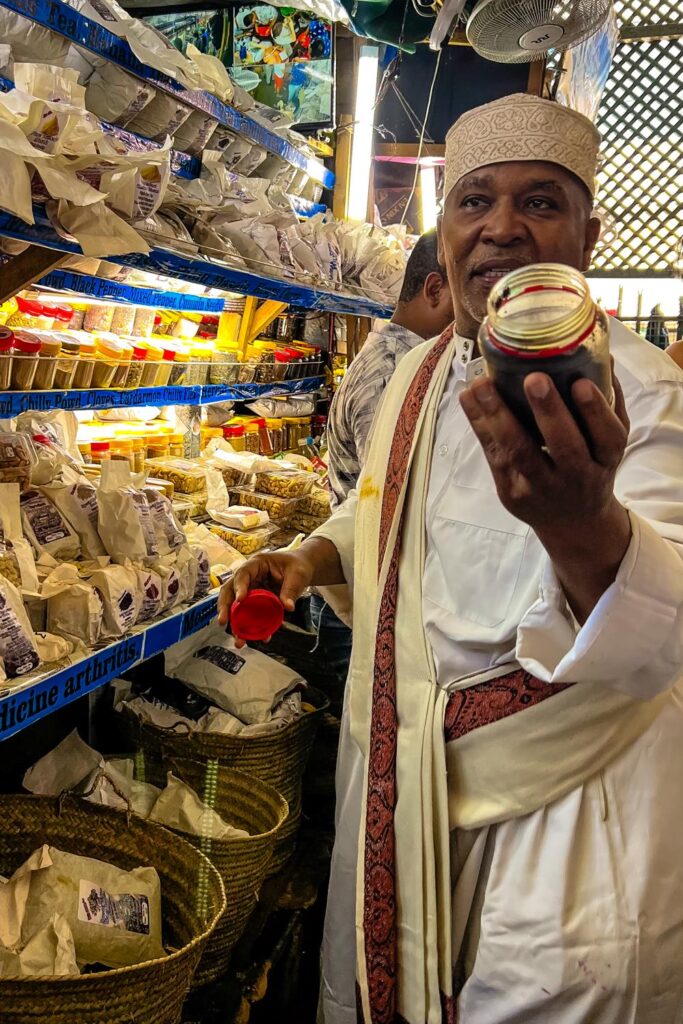
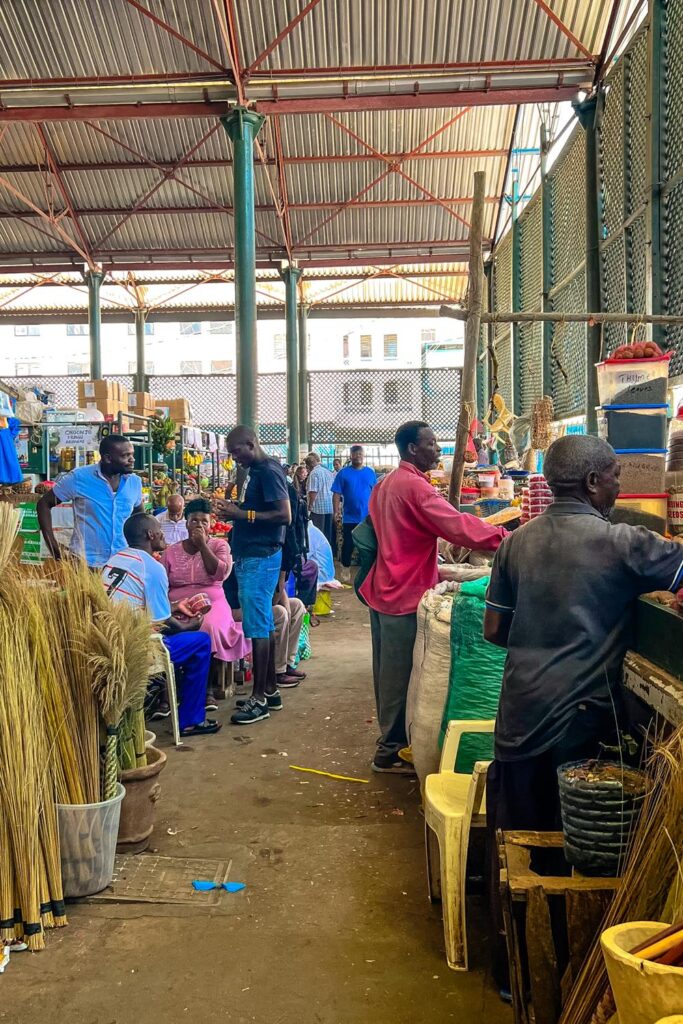
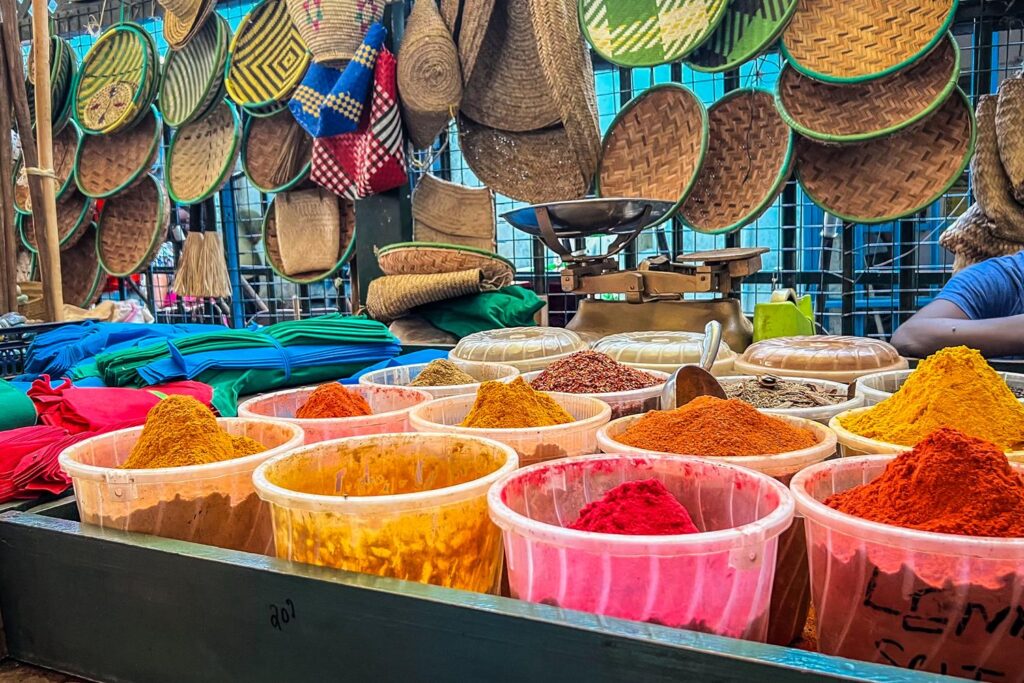
Akamba Tribe Artisan Workshop
The Akamba tribe’s artisan workshop is a place where skilled craftsmen have been intricately carving exotic woods for generations. It’s a haven for discovering unique figurines and true works of art, but, above all, it offers a chance to witness the captivating process of creating these one-of-a-kind sculptures.
Artisans here expertly craft pieces from exotic woods like ebony and mango, producing exquisite figurines and diverse objects with various shapes and designs. This presents an excellent opportunity to gain insights into local artisan techniques and to acquire authentic souvenirs crafted from exotic wood at reasonable prices.
Confidence in the quality of materials and the craftsmanship is evident throughout, with most products featuring descriptions detailing the type of wood used and the craftsman responsible for creating the piece.
See also:
The Akamba Tribe’s Manufactory – An Unusual Place In Mombasa
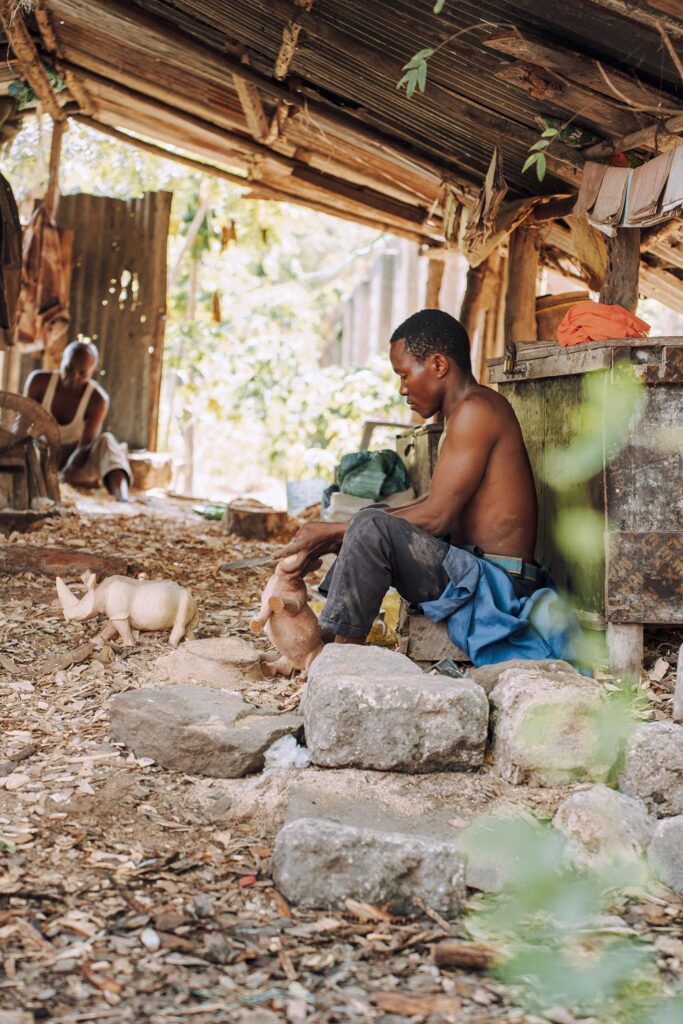
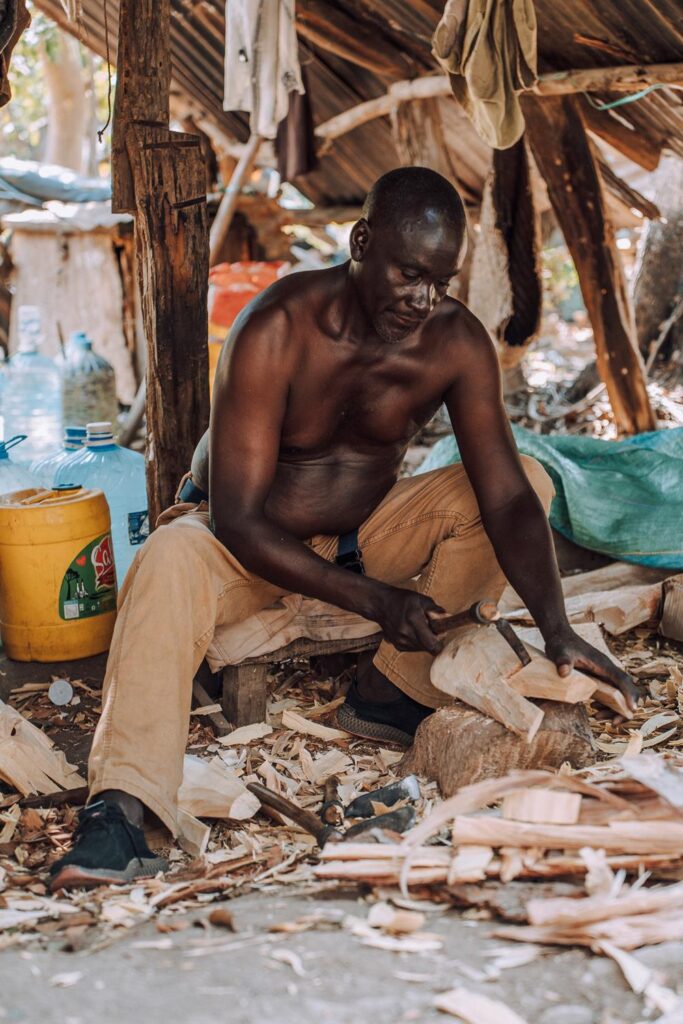
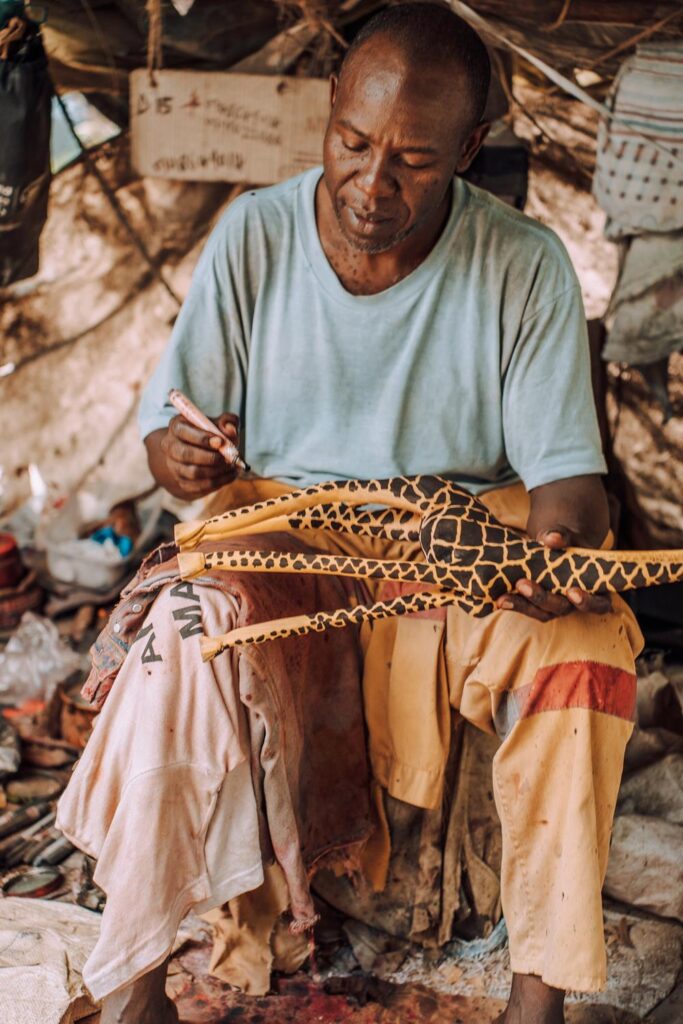
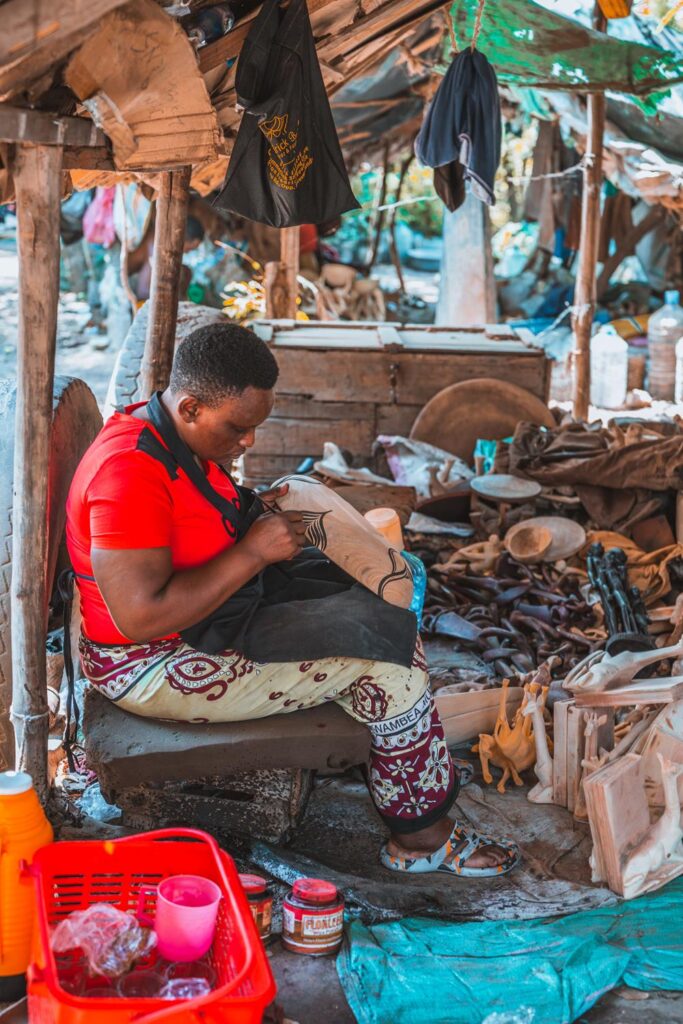
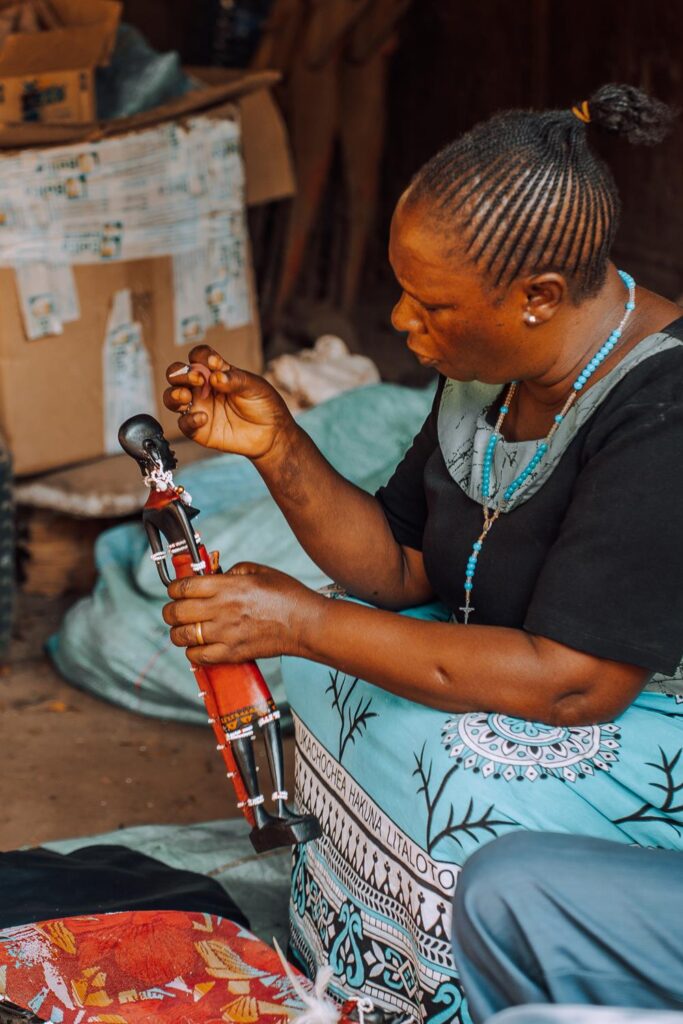
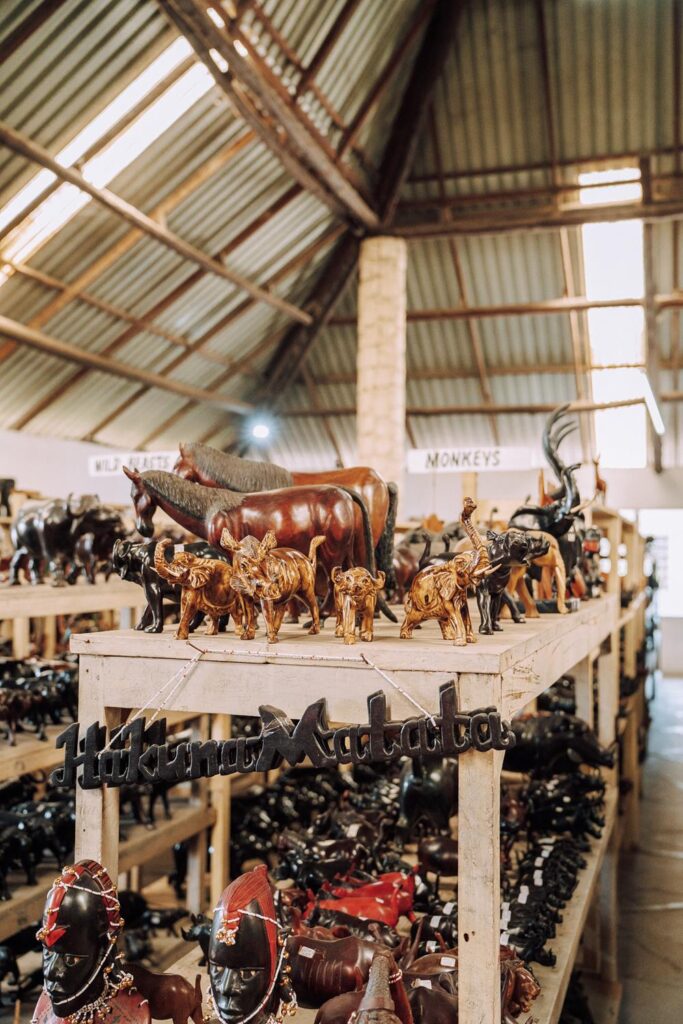
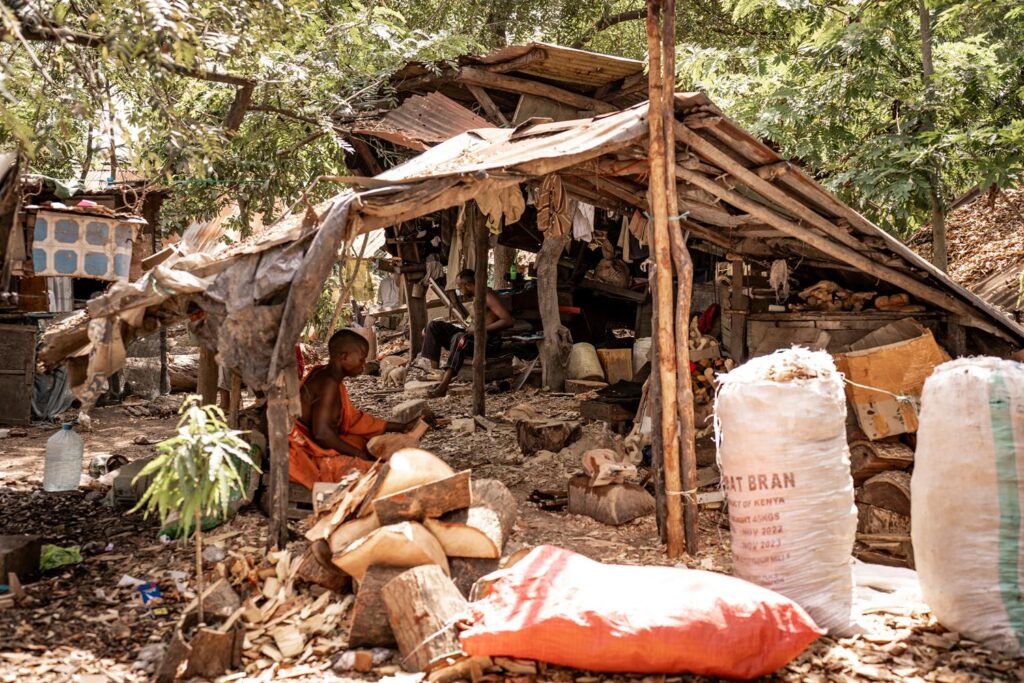
Beaches in Mombasa
Bamburi Beach is located on the north coast of Mombasa, about 12 kilometers from the city center. It is a popular resort area that attracts both tourists and locals. The beach is famous for its wide stretch of white sand and the turquoise waters of the Indian Ocean.
One of the distinctive features of Bamburi Beach are the coral reefs, which provide an excellent place for diving or snorkeling. The reef offers a remarkable underwater experience and is home to a rich diversity of marine life.
Nyali Beach is another gem on this exceptional list. Its wide coastline and warm, sandy beach is the perfect place for romantic sunset strolls or family picnics overlooking the horizon.
For lovers of relaxation and water activities, Diani Beach is a heavenly place. Stretching for several kilometers, the coast offers unforgettable walks along the shore and excellent conditions for water sports.
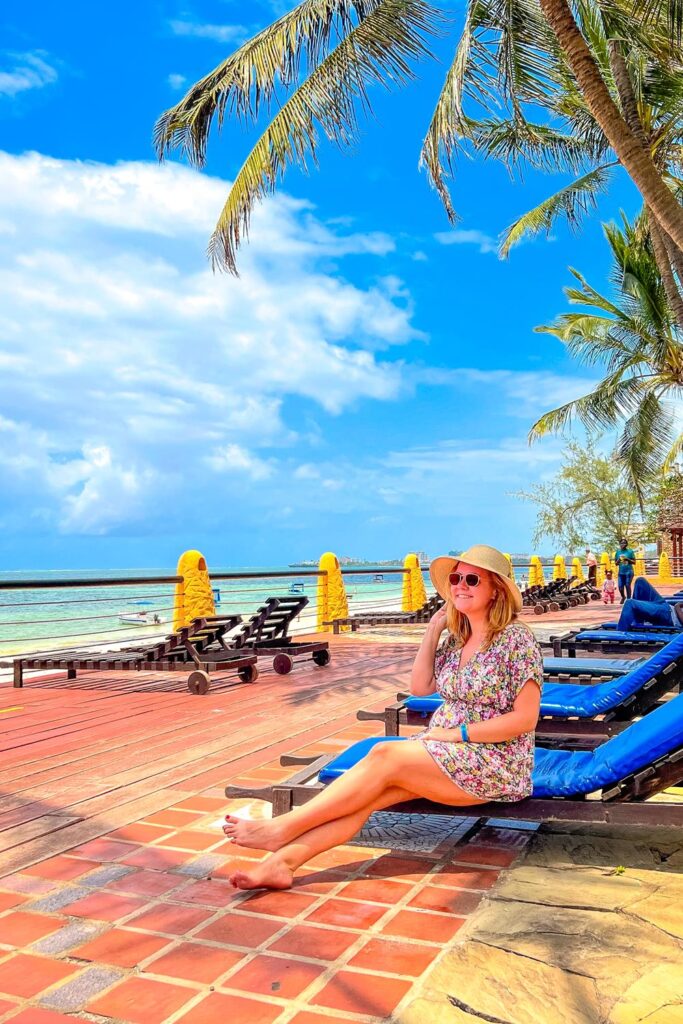
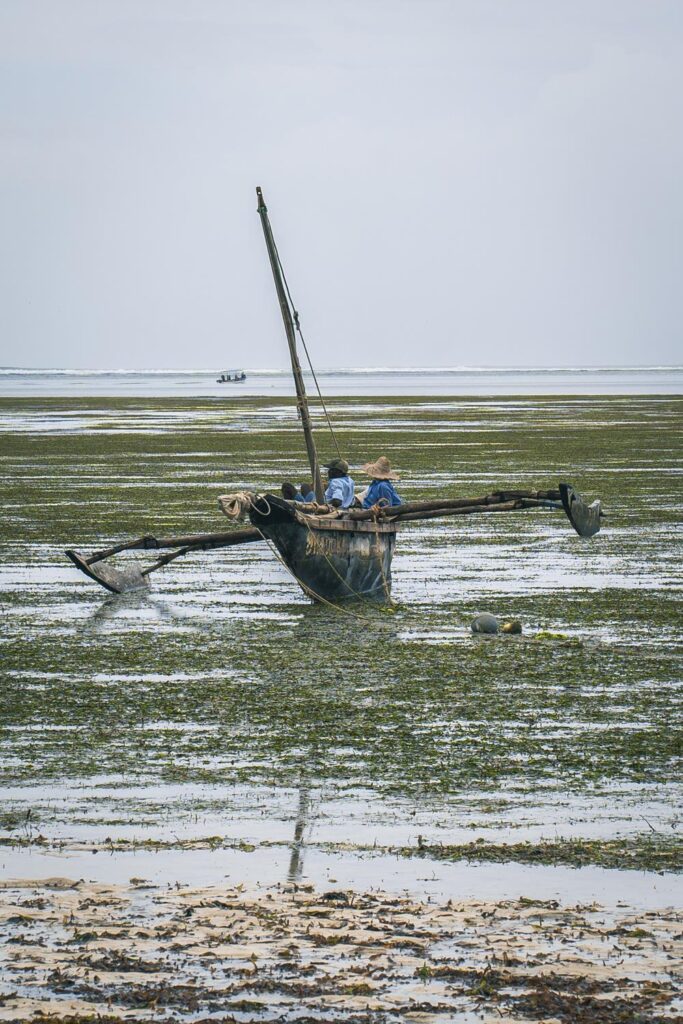
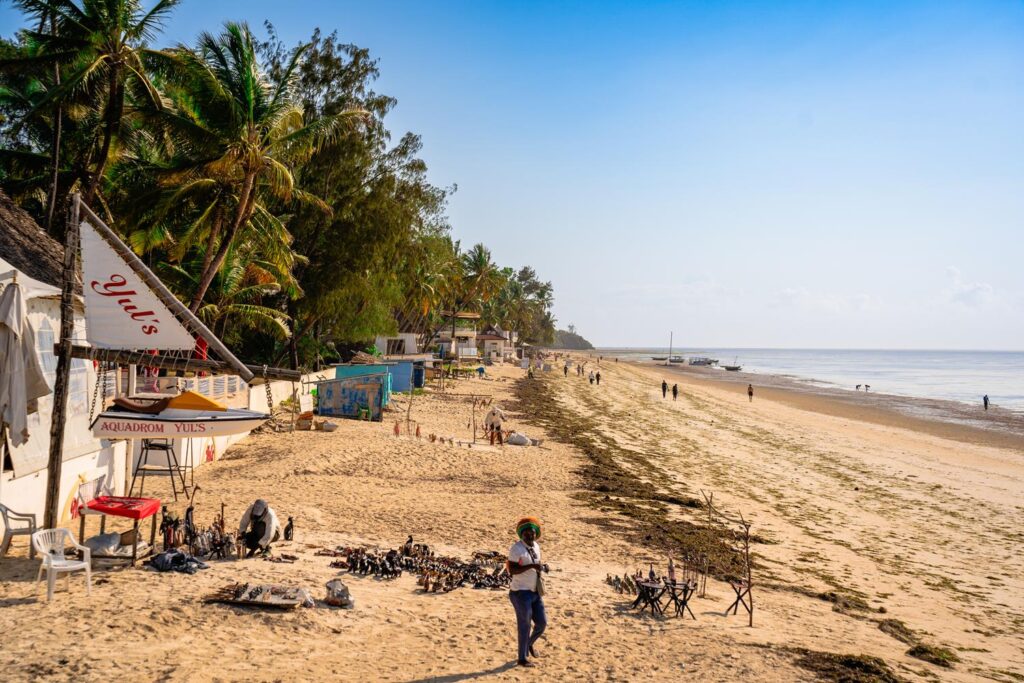
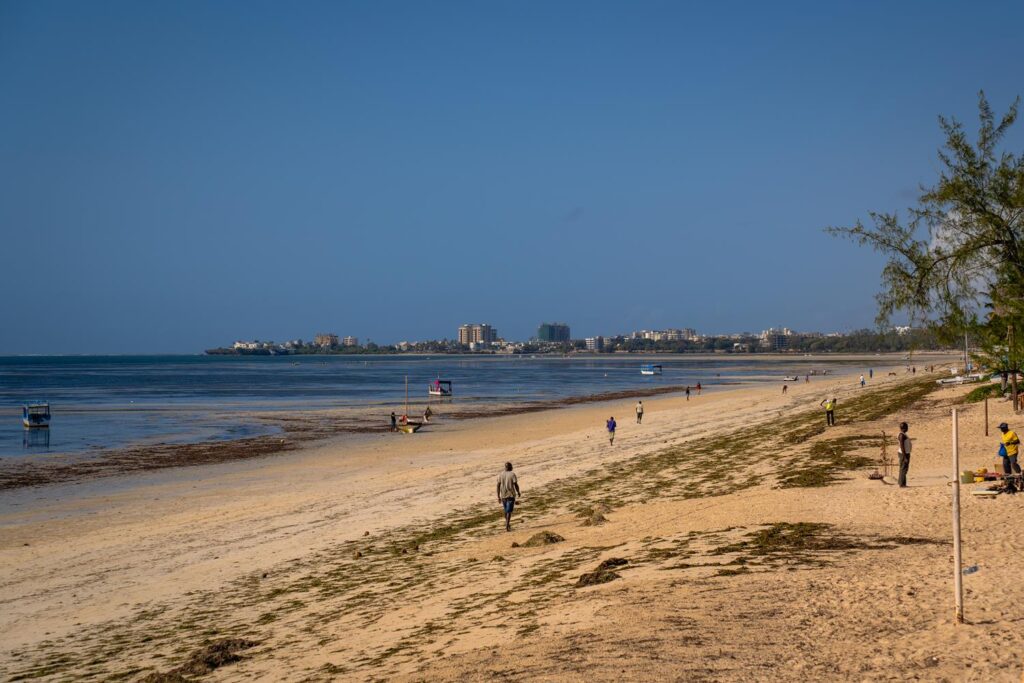
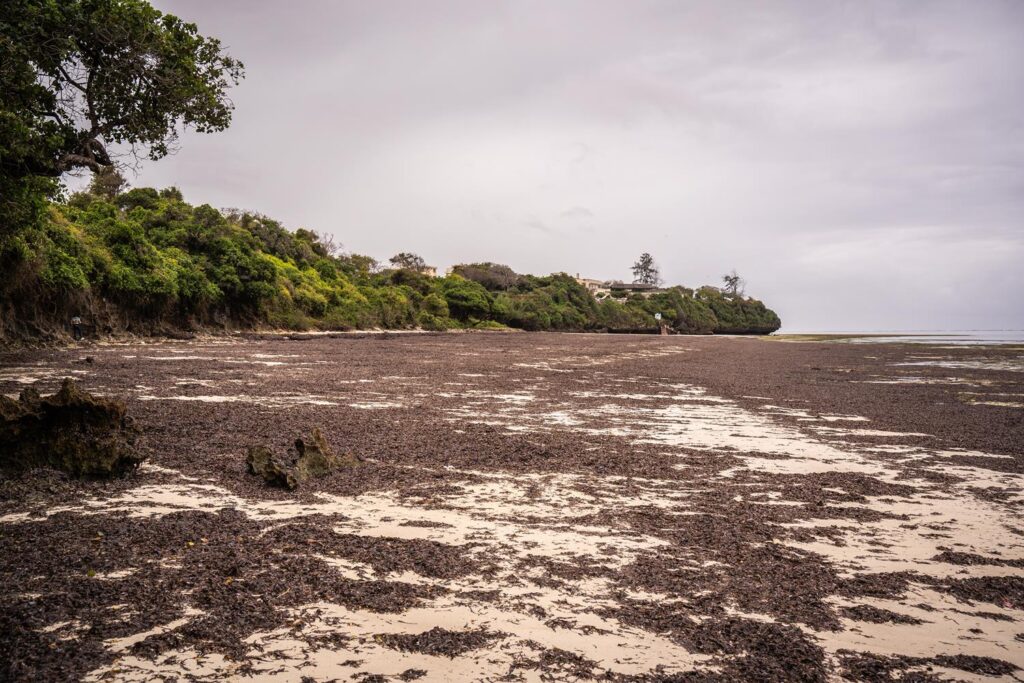
Other Attractions in the Mombasa Area
The Mombasa area offers a wealth of fascinating places to explore, with one of the most popular being Haller Park.
Haller Park provides visitors with an opportunity to immerse themselves in Kenya’s diverse wildlife. Here, you can encounter numerous species, including giraffes, buffalo, antelopes, crocodiles, and various birds. Additionally, the park houses a marine care center. A noteworthy highlight is the chance to interact with giraffes by feeding them directly from your hand.
For nature enthusiasts seeking a more educational experience, the Nguuni Nature Sanctuary is another captivating destination. It offers a welcoming and informative environment where you can delve into Kenyan flora and fauna.
Accommodation in Mombasa
Mombasa offers a diverse range of lodging choices to cater to various preferences and budgets. You can find luxurious oceanfront hotels as well as budget-friendly hostels and guesthouses for travelers seeking economical options. It’s advisable to read reviews before making your reservation, especially if you prioritize amenities like air conditioning or hot water. ?
To discover the finest selection of accommodations, please refer to the following link:
Dining Options in Mombasa
When it comes to dining in Mombasa, you’ll have various choices at your disposal. During my visit, I primarily dined in hotels that offered a delightful array of both local and international cuisines, including European and Asian dishes. The food here is known for its delectable flavors.
If you’re in the mood for burgers or pizza and looking for a restaurant recommendation, I suggest trying Java House. Their offerings are quite satisfying, and they also serve delicious mango juice. However, it’s worth noting that the waiting times can sometimes be on the leisurely side, but the experience is well worth it. ?
Mombasa – Why It’s Worth Visiting
Mombasa may not fit the mold of a meticulously pristine tourist destination, and it’s essential for prospective visitors to be aware of this fact. However, this is by no means a reason to dismiss Mombasa as an unworthy destination. It’s crucial to understand this to avoid any disappointment, especially if you anticipate the Old Town to resemble cities like London. ? Some of the structures in the Old Town are in dire need of renovation, as our guide aptly put it, “Today this building stands, but tomorrow, it may not.” Of course, this doesn’t apply to all buildings, but some might give that impression. Additionally, certain streets may not be particularly inviting for walking, with scattered garbage in some areas that emit unpleasant odors. Furthermore, the traffic in Mombasa can be quite chaotic, making even a bustling city like Bangkok seem comparatively peaceful.
However, what makes Mombasa truly worth visiting goes beyond its historical significance. In my opinion, it’s the experience itself that holds value. The stark contrast between the opulent hotels and the everyday lives of the less affluent residents you encounter on the streets can be eye-opening. It encourages reflection and provides food for thought, ultimately enriching your perspective on the world.
See also:
Safari in Kenya – What You Need to Know?
Explore Amboseli National Park: Wildlife and More in Kenya
Tsavo West – a national park where you’ll encounter Africa’s Big Five